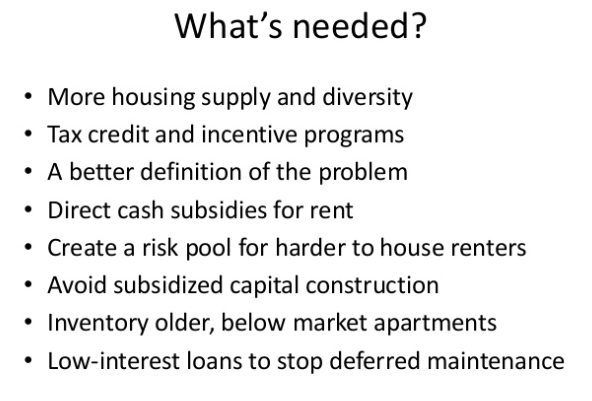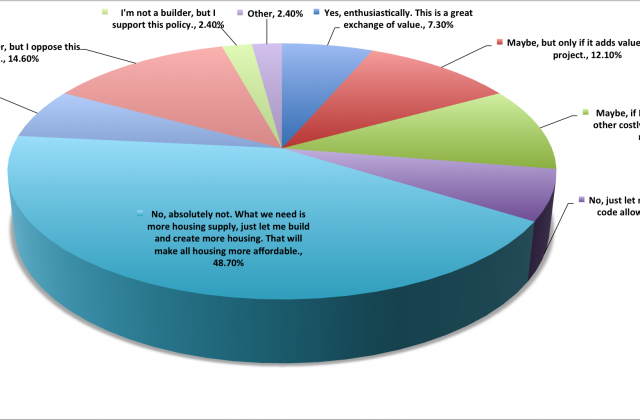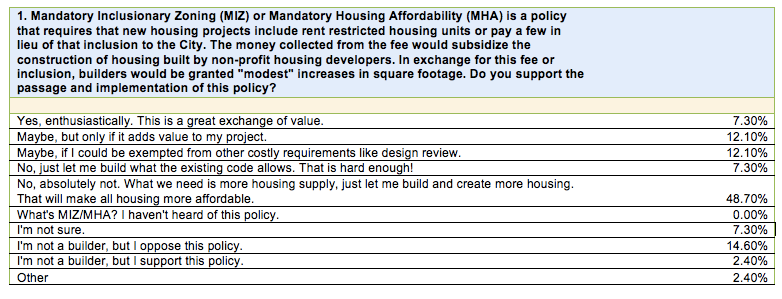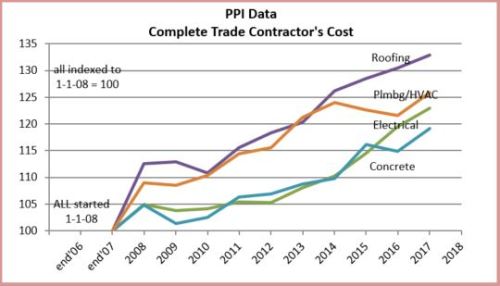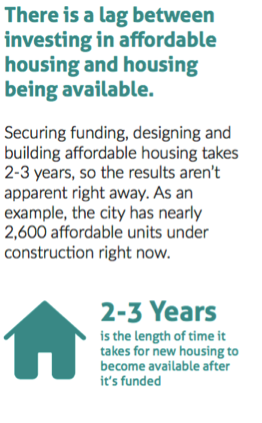Presentation: Rent Control Looms Over Chicago
I enjoyed my time with the Chicago Association of Realtors. Unfortunately, their members are facing many of the same issues as people in the real estate business in Seattle are dealing with. I pointed out that supporters of rent control don’t really believe in private property, or at least they don’t think anyone should be denied the use of someone else’s private property for housing with few if any terms. What’s happening in Chicago, in spite of falling prices, is the ideological assertion by some that people who own and operate buildings shouldn’t be able to set their own rents. But tenant advocates want other things too, like limiting the ability of property owners and managers to screen tenants. What makes the bad policies being pushed worse is that they are coming incrementally with the same broad intent: deny people who make a living owning and managing rental properties unable to do that.
If a take over of all rental properties by the government was openly stated by tenant groups they’d likely get no support. So they’re taking it one step at a time. First in time legislation, banning screening for criminal backgrounds, more inspections, more fees, more requirements for deposits and other unrelating things like voter registration. Taken together these along with rent control would make privately owned rental properties an extension of City government. In my presentation I offer some ideas for offering positive solutions. We’ll also need better data and messaging. It’s a long fight ahead. We have a lot of work to do all over the country.
“Stormy, husky, brawling, City of the Big Shoulders:” Rent Control in Chicago?
It’s been years since I have been to Chicago, but I was honored to get an invite from the Chicago Association of Realtors to talk with them about rent control. As I was putting together my comments I noticed two things, first, rents are going down in Chicago. The city seems to be producing enough housing over the last year to absorb demand. One report from rent tracking website Per Zumper found rents dropping about 15 percent.
From that article:
In Chicago, “both bedroom types are down over 15 percent since this time last year, which are the largest rent dips in the nation,” said Zumper Marketing Manager Crystal Chen.
“This steady downturn in prices the past year is most likely due to the influx of newer apartment buildings with move-in specials and an overall increase in inventory, which may be a relief to renters.”
But here’s something else that is happening in Chicago: a movement pushing rent control.
From the Chicago Tribune:
The coalition’s efforts have already resulted in a question about rent regulation slated for the March primary ballot in nine wards and about 100 precincts around Chicago, Malone said. Couple that with state Rep. Will Guzzardi, D-Chicago, introducing a bill to the state House last year repealing the rent control ban and Democratic gubernatorial candidates J.B. Pritzker and Daniel Biss expressing support of a repeal and you have a number of people optimistic about the repeal coming to fruition.
And how did that question about rent control fair on the ballot in March? About 75 percent of Chicago voters said, “Yes” to the question of whether to repeal the state prohibition on rent control at the local level.
Again from the Chicago Tribune:
Another 75 percent of votes, most of them in traditionally Latino wards seeing a dramatic rise to the cost of living, aim to get rid of an existing prohibition on rent regulation that goes back to 1997.
The majority of voters in participating precincts said “yes” to lifting the ban on rent stabilization as a way “to stop gentrification and rapidly increasing rents in Chicago”, the ballot read.
Proponents said they are not interested in freezing rents or hurting homeowners, but in finding state-sanctioned solutions directed mainly at real estate developers, in order to keep properties affordable for families
So rents are going down, but interest in rent control is up. I’ll see what I can find out. Meanwhile, here’s Carl Sandburg’s paean to the city.
Chicago
The poem, Chicago, first appeared “in Poetry, March 1914, the first of nine poems collectively titled “Chicago Poems”. It was republished in 1916 in Sandburg’s first mainstream collection of poems, also titled Chicago Poems . . . One of Chicago’s many nicknames, “City of the Big Shoulders,” is taken from the poem’s fifth line.” — From Wikipedia
The City of Seattle is Violating the Law….Again
The City Has Not Implemented Income Guidelines Established by HUD as Required by State Law
The City is at it again. As of today, the City’s Office of Housing has not implemented income guidelines set by HUD for the City’s Multifamily Tax Exemption (MFTE) program. If implemented, this would means adjustments to the rent being paid by tenants in MFTE units.
The reason.
The City doesn’t like the new income limits because rents could go up.
Rents go up because there isn’t enough housing, something the City Council has ensured with overreaching regulation on the production of housing.
Remember when the City tried to force developments below the threshold of design review to do it anyway and lost in court. That’s just one example of blatant contempt for the law.
Now they are ignoring the law again, something that is bad enough but this is yet another disincentive to participate in the program which has produced thousands of affordable units very efficiently. This won’t make the city’s housing problems any better, only worse.
Below is the letter we sent to Deputy Mayor David Mosley and Steve Walker the head of the Office of Housing. We’ve still heard no response 10 days later.
—————–
Hello David and Steve,
We recently became aware of a determination by the City’s Office of Housing to abrogate previous practice and the requirement in the Seattle Municipal Code (SMC) to follow the income guidelines set annually by the Department of Housing and Urban Development (HUD) when setting rent limits for programs like the Multifamily Tax Exemption (MFTE) program.
Here’s a link to the statement and the relevant passage:
https://www.seattle.gov/housing/property-managers/income-and-rent-limits
Housing supported by the Office of Housing is rent- and income-restricted to ensure that the affordable units we fund are occupied by those who need it most. The below income and rent limits are based off HUD figures, annually updated, and posted as soon as they are available. Each program has a particular income focus and requirements, and is thus listed separately.
The United States Department of Housing and Urban Development (HUD) published the 2018 Seattle-Bellevue, WA metro area income guidelines on March 30. Historically, income and rent limits for City-supported affordable rental housing programs have been based on the HUD income guidelines. Using the previous methodology, the 2018 HUD income guidelines would result in an 11.5 percent increase in rents, compounding a 6.3 percent increase in rents in 2017. In light of the significant two-year increase, the Office of Housing 2017 published rent and income guidelines will continue to apply to all City-supported affordable rental housing programs until further notice.
The City is not implementing the 2018 HUD guidelines as it always has.
This decision violates the plain language of state law (see Revised Code of Washington 84.14.010) authorizing MFTE and the City Code. More specifically, see SMC 5.73.020 where the City Code explicitly defines “median income” as:
“Median Income” means median family income for the Seattle area, as published from time to time by the HUD for the Section 8 program. If in any year HUD shall publish median family income data for more than one area that includes Seattle, then unless otherwise approved in writing by the Director of the Office of Housing, the lowest of such median family income figures shall be used. If, at any time, Median Income for a Family size cannot be determined under the foregoing sentences based on data published by HUD for the Seattle area within the most recent 13 months, then the City may determine Median Income for such Family size based on any data for the Seattle area or an area including Seattle, published or reported by a federal, state, or local agency, as the City shall select in its sole discretion, adjusted for Family size in such manner as the City shall determine in its sole discretion.
The City can stray from the highlighted sentence only if HUD’s data is not available. Thus, the City cannot decide not to follow HUD’s data because it does not like the new figures.
Was this an error? Will you correct this information on the website and elsewhere and implement the HUD standard as required?
Can we get a response to this issue as soon as possible?
Thank you!
Survey Says:Builders Oppose MIZ/MHA, Support Legal Challenge
The sample size is small, just 41 people. After doing many surveys over the years I’ve found that it is very difficult to get people to respond. It’s irritating. Until I consider that when I get surveys it often takes me a week to 10 days to respond and because I’ve fielded surveys I am pretty committed to answering them too. That being said, I think these numbers are worth sharing. While this is not a statistically valid survey, it was intended to try out a new survey tool and to give people on our list a chance to respond to these questions. The take away is that of the people that responded there is very little support for the policy of mandating set aside units or paying a fee in lieu of that set aside. There is also support for a legal challenge and for Seattle For Growth maintaining our public criticism of the policy. Interestingly, there is also interest, as I suggested in my post yesterday, in trade offs. There is still a chance the City could make this policy better, an actual exchange of value, if it would stop and listen rather than plowing ahead. Let’s look at the responses and comments.
My issue is that its MANDATORY and not an option, options are good, mandatory is not good.
City regulations absolutely add costs to new housing supply thereby reducing the overall supply that is produced (by making fewer projects feasible) resulting in a higher equilibrium price of housing (ie, higher rents).
We have stopped purchasing land in Seattle until we see what the actual costs will be to our company to build units in Seattle.
Yes, MIZ/MHA is the wrong way to tackle housing affordability. Instead we should do things to add more housing supply.
I’m glad that Seattle for Growth is making our case with the city and fighting for the housing producers . . .keep up the good fight.
Again, a small sampling, but all voices are important, even small and few voices. The bottom line is that we’ll keep working every angle to get to accomplish our mission, more housing of all kinds, in all parts of the city, and for people of all levels of income.
Just One More Thing: Even if Jobs Tax Did What it is Supposed to do, it Wouldn’t Solve Housing Problem
I hate to be such a bother, but there’s a few things about this proposed jobs tax that bother me. Maybe you can help answer these questions.
So here’s the City of Seattle’s logic on why they need to tax jobs in Seattle. Their proposed tax would charge businesses $75,000,000 million dollars a year based on the number of employees they have. That money, they say, is set aside to solve homelessness.
However, the number stated by Councilmember Lorena Gonzalez as a rationale for this tax is the 29,000 households she and the City claim are cost-burdened, that is, households paying as much as half their income on housing. Nowhere is there a clear statement of where this number comes from, but one can guess that it comes from 2015 documents the City created using US Census data from earlier.
The next part of the City’s proposal is that roughly 75 percent of the of the $75,000,000 will go toward subsidized non-profit housing, about $57,000,000 per year. The City says that they will support the construction of 1,780 units of housing over 5 years or 356 units per year; that’s about $160,000 per unit.
Then, in a series of non-sequiturs, the City suggests that there are about 2,580 units in production which when added to existing presumably occupied non-profit subsidized units, the total number of units of subsidized housing will be 15,000 units citywide. Then the City says that the regional need is 140,000 units. There is no reference or note as to where these numbers come from or relate with the 29,000 households, the ones “with the greatest barriers to housing.”
So, taking a look at these numbers the key questions are:
How much will the 356 units cost per year total?– An analysis we completed of 8 years of housing created in Seattle using Housing Trust Fund dollarsfound that the cost in 2016 for a unit of housing was about $325,000 per unit. Using division, the cost per unit under the jobs tax would have to be more like $160,000 per unit at a constant over 5 years. Is it possible to build units for that much over the next 5 years?
If there is other money being put forward where is it coming from? And what happens if costs go up as they did between 2008 and 2016, the years of our look at housing costs?The increase in those costs was 43 percent. The Producer Price Index (PPI) has been rising, with building materials rising dramatically.
Is the City’s goal to eliminate the cost burden of the 29,000 people Councilmember Gonzalez references? If it is, then the $57,000,000 per year over 5 years would only create a small dent in that problem, dropping that number, in 5 years, to 27,220. If we include the suggested 2,580 in production now, that number could go down to 24,640 households, if that number stays constant over 5 years.
In the City’s one pager, however, they defend the lack of progress on housing affordability suggesting that housing takes time to build. Here’s their graphic:
So, has the City figured out how they are going to speed that process up? If the first money collected in 2019, then the first units of housing wouldn’t be available until 2022? So the cost burdened households will have to wait until then to get housing? How can families struggling to pay rent next month be sure they can hang on until then? Can they apply for this housing now?
On top of this, the City’s one pager says there are over 8,500 people in Seattle who are homeless. Are these people eligible for the housing? In that case, the actual number the City should be using to establish the need is more like 37,500 households, isn’t it?
Our look at non-profit housing production found that about 300 units were created each year between 2008 and 2016, for a total, over 8 years of about 2,400 units at a total cost of about $600,000,000 or about $250,000 per unit. If the City thinks it’s going to “leverage” other dollars, won’t that add to the production lag of the 3 years that they describe in the one pager?How do they plan to increase historic production by two or three times?
Assuming a doubling of that rate of production from all sources of funding, and a cost of $160,000, over five years about 3,000 units could be created at a cost of $480,000,000 or $96,000,000 per year. Does the City expect funding from other sources in the amount of about $40,000,000 per year?Where is that money coming from? Is it set aside? I thought tax credits were dropping by 14 percent, right?
Based on the City’s assumptions in its Mandatory Housing Affordability (MHA) program, the City will collect and grant out about $472,000,000 from MHA fees to produce 6,320 units of housing by 2025, about 1,264 units per year. Is there any overlap between these units and the units being funded by the tax on jobs? How many?
| MHA | Cost per Year | Jobs Tax | Cost per Year | |
| 2019 | 1000 | $78,666,667 | 356 | $57,000,000 |
| 2020 | 1000 | $78,666,667 | 356 | $57,000,000 |
| 2021 | 1000 | $78,666,667 | 356 | $57,000,000 |
| 2022 | 1000 | $78,666,667 | 356 | $57,000,000 |
| 2023 | 1000 | $78,666,667 | 356 | $57,000,000 |
| 2024 | 1000 | $78,666,667 | 356 | $57,000,000 |
| 6000 | $472,000,000 | 2136 | $342,000,000 |
If we align the two programs over a five year period, assume a production cost of about $100,000 per unit, and that the housing could be delivered almost immediately, the two programs together could have housed almost all of the 8,500 people sleeping outdoors tonight by 2024 at a cost of about $814,000,000. This would require a production of 1,627 units per year over that period and it would assume constant costs and a steady population of need. That’s an increase of about 5 times the rate of production between 2008 and 2016; is that possible to do?
If the programs are intended to overlap, then the number of units would be less than this and would obviously house fewer people over the period at a higher cost per unit. Is it the City’s plan to subsidize the acquisition of land, financing and construction at this pace between now and 2025? Is this even feasible? And if it is, is the City satisfied that it will have reduced the measured problem from 37,500 households down to 29,364 by 2024? Is that their goal? What is their measure of success? And doesn’t this scheme assume a constant need?
And what do people in those 37,500 households do while all this housing is being built? Wouldn’t it just be better to help people with a few hundred dollars in rent money, now?
Sorry for all the bother.
